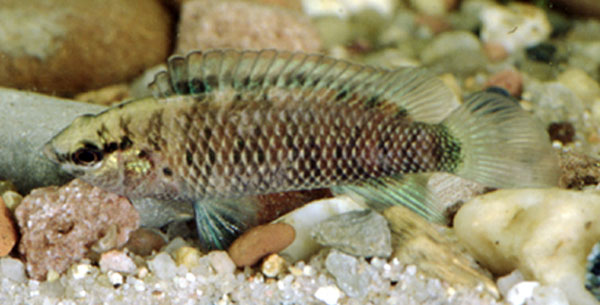| Badidae (Chameleonfishes) |
| 7.1 cm TL (male/unsexed); max.weight: 2.6 g |
|
benthopelagic; freshwater; pH range: 6 - 8; dH range: 5 - 19, |
| Asia: Ganges River drainage in India, Bangladesh, and Nepal, from Himachal Pradesh (Yamuna River) to the estuary; the Mahanadi River drainage; Assam lowlands close to Brahmaputra (Kaziranga, Gauhati, and Dibru River) (Ref. 46238). Also reported from Bhutan (Ref. 9418) and Pakistan (Ref. 52665). |
|
Dorsal spines (total): 15-17; Dorsal soft rays (total): 7-10; Anal soft rays: 6-8; Vertebrae: 26-28. The species has conspicuous dark blotch covering superficial part of cleithrum above pectoral fin base. Lacks a dark caudal peduncle blotch. Body depth 30.7-38.9%SL; interorbital width 6,5-8,3% SL; scales in lateral row 25-27; circumpeduncular scales 19-20; pectoral rays usually 12. Has a series of prominent dark blotches along dorsal fin base and/or a series of dark blotches along middle of dorsal fin; and has indistinct bars on side. Has a distal extrascapular (Ref. 46238). |
| Occurs solitarily in rivers, ponds and ditches. Also found in swamps (Ref. 1479). Feeds on worms, crustaceans and insects (Ref. 7020). Used for behavioral studies (Ref. 4537). Length indications of up to 8 cm in some publications are exaggerated (Ref. 89918). |
|
Least Concern (LC); Date assessed: 26 March 2010 Ref. (130435)
|
| harmless |
Source and more info: www.fishbase.org. For personal, classroom, and other internal use only. Not for publication.
